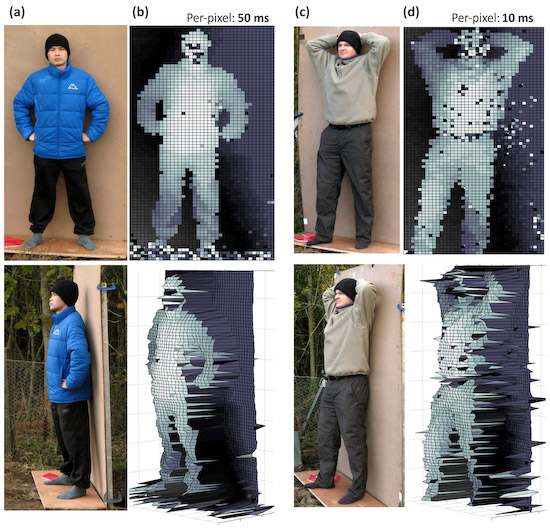Featured Products
Researchers have developed a laser-powered camera system that records high-resolution 3D images of objects, from up to a kilometer (3000 feet) away.
The process is named Time-of-Flight (ToF) depth imaging, based on the time it takes for the light emitted by a laser to travel back to its source, after bouncing off the photographed object.

Researchers tested the camera on themselves, from a distance of 910 meters. The laser’s long wavelength makes it safe for eyes.
Until now, long distance 3D imaging range was very limited
The technology applied here is similar to radar, but makes use of light, instead of microwaves. For mapping out objects or scenes in 3D, scientists project a laser beam and measure how long it takes for the light to return.
ToF depth imaging is already being applied in machine vision and navigation systems for autonomous vehicles.
Up until now though, the range covered was relatively short. Also, ToF devices had trouble with a lot of surfaces that don’t reflect infrared light properly.
Scientists from Edinburg, Scotland have recently dealt with these shortcomings, and reported their results in the Optical Society’s international journal, Optics Express.
Millimeter scale precision over long distances
Led by Gerald Buller, a professor at Heriot-Watt University in Edinburgh, a team of researchers has managed to record detailed high-resolution 3D images of objects, from up to a kilometer away.
Their camera system rapidly sweeps low-powered laser beams, over long distances. It then captures the returning light, and plots each individual photon’s round-trip time on a matrix, pixel-by-pixel.
As opposed to past depth imaging machines, this one uses longer wavelengths of laser (around 1560 nanometers), which enable recording a higher range of textures, like articles of clothing.
These longer wavelengths, of over 1550 nanometers, have better attenuation of atmosphere, which means they travel faster, and their signal is easier to detect, standing out from the solar noise level. Both of these factors contribute to the augmented range of up to one kilometer.
Another positive aspect of this wavelength is that it’s safe for eyes, if used at low power.
Even though it can distinguish clothes, the camera cannot process human faces yet, due to the fact that skin absorbs light easily. However, the skin’s reflective characteristics improve when perspired.
Besides eventual face identification, the camera system can be used for navigating in difficult visibility conditions, or as Gerald Buller suggests, scanning vegetation health from airplanes, assessing potential hazards, by measuring geological changes, or improving the mapping of oceans.






































